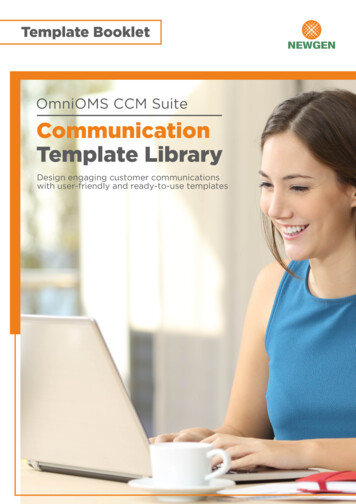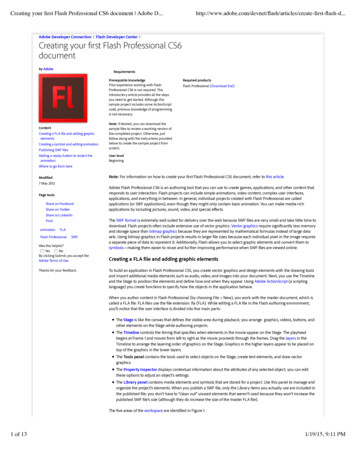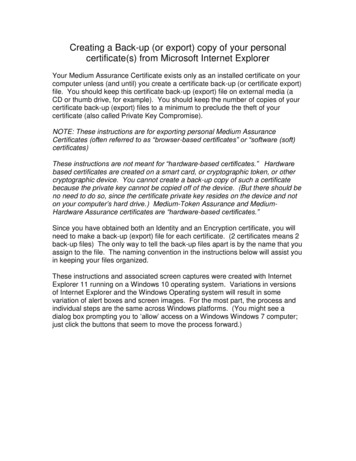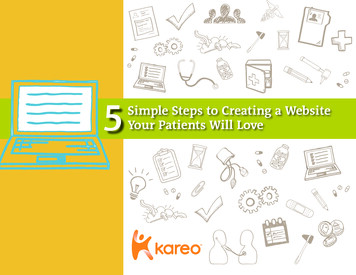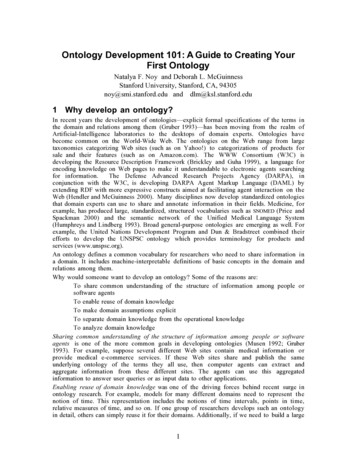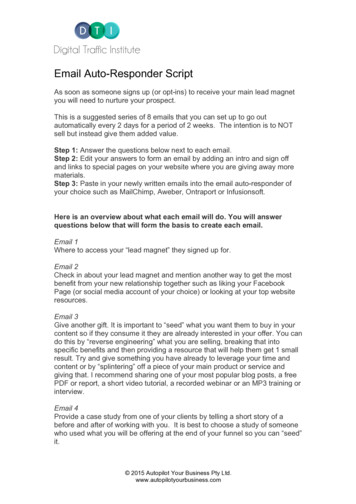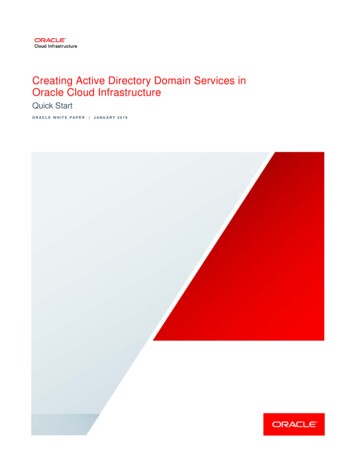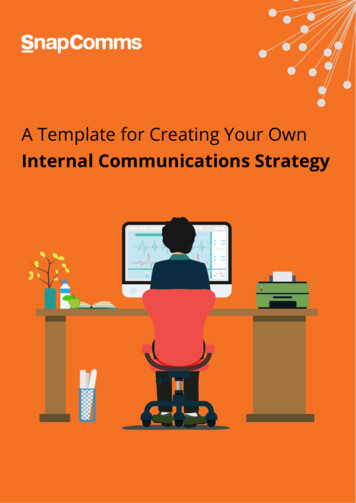
Transcription
A Template for Creating Your OwnInternal Communications Strategy1
INTRODUCTIONCongratulations!You’ve just taken an important step in getting your internal communications (IC) planningon track.For more than ten years, we’ve been working with many of the world’s largest internalcommunicators to get employee attention.From communicating change, to nurturing culture; from improving awareness to drivingbehavioral shifts; you could say we’ve been there, done that, and got the T-shirt!We’ve harnessed that experience and compiled this strategy template to help guideorganizations of all shapes, sizes and sectors to boost the impact of their internalcommunications.CONTENTSBEFORE YOU START . 3Internal Research . 3Working Party . 3Outcome Focused . 3STEP 1: WHERE YOU ARE NOW . 4Current Situation Analysis . 5Review of Existing Channels . 5Audience Segmentation. 5STEP 2: WHERE YOU WANT TO BE . 6Communication Priorities . 6Choosing the Right Channels . 7STEP 3: HOW TO GET THERE . 8Build Your Comms Plan . 8Staff surroundings. 9Evaluate and Evolve . 9Two-way Feedback . 10EFFICIENCY TIPS . 10BUILD YOUR OWN TEMPLATE. 11REQUEST A DEMO . 12ABOUT SNAPCOMMS . 122
BEFORE YOU STARTCreating an internal communications strategy is not a complicated task. But it does require putting timeaside to focus on getting the basics in place.We recommend breaking it into three stages:1)2)3)Where are you now? - A review of how well employees feel communicated and engaged with;Where do you want to be? - How your IC actions will support key business drivers, such as vision,corporate plan, employee engagement, corporate communications and people strategies;How to get there? - Setting objectives and tactics for successOur advice is keep things simple to start with. An output document of no more than a couple of pages ismore likely to get read and referenced by others, than an overly complex piece of work that never sees thelight of day.This document outlines a three-step process for creating a custom-built IC strategy for yourorganization.TIP:Use the same headings and subheadings in your document (see page 11, Templates). This will help you stayon track and ensure you consider all elements for creating a robust IC strategy.Before you start, complete the following: Undertake Internal ResearchIt’s important to gauge how your internal communications efforts have been performing, and the level ofstaff engagement.These findings will reveal where your efforts need to be concentrated, and enable you to benchmark forfuture progress.Launch some basic internal research, with the help of your Human Resources teams. There are many ways tocapture this information, such as employee pulse surveys, monitoring online chat rooms, listening out foranecdotes, and simply going out and speaking to staff across all levels.Ask how well they understand the organization’s purpose; their recall on some of the recent IC messages;how they’d prefer to be communicated with; and their ideas for improvement. Create a Working PartyIt’s a good idea to form a small working group to help bounce ideas around and garner support. Ideally thisteam should not exceed 8 – 10 members.The group should represent different areas, demographics and seniority from the organization. Define Outcome-Focused ObjectivesBe specific about what you want to achieve. For example, ‘Improve employee engagement’ is OK but quitebroad. Consider adding what the success indicators are for each objective. Suggestions include:3 increase staff retention rate by XX %; improve participation for training programs/company events by XX %; improve survey completion rates; increase staff referrals for new hires.
STEP 1: WHERE YOU ARE NOWThis section focuses on what’s currently working and not working, and how you canspot the difference.Current Situation Analysis Review all communications published in the last 12 months. The tone and style of your comms maydiffer considerably from your colleagues’.Check for consistency and delivery issues e.g. lack of targeting, slow or missed messaging, distributedworkforce, too much or too little information, not all staff having access to a device. List what the main objectives or issues are that need addressing. When do these need to happen,what are the influencing factors, and how do these fit with your company’s mission, values and keyperformance indicators (KPIs)? This will entail canvassing the communication requirements from eachdepartmental head. Complete an exercise which describes the composition of your organization. This should includenumber of staff, location, departments, demographics, access to computing devices, and any otherfactors that form part of your organizational structure. Remember to include forecasts and trends – for example, will staff be increasingly working fromhome? Will you be recruiting more part-time or contract staff? Are there plans for expansion into newterritories?4
Review of Existing ChannelsIf you want to achieve different (better) results, that means exploring new ways and doing thingsdifferently.In response to the universal problem of information overload within the workplace, a range of innovativecommunication tools have become available. But before you jump in and buy the latest shiny new object,think like a marketer and understand your target market i.e. your staff.First of all, understand which existing communication channels are the most effective; are theymeasurable; what impact are they having; who’s reading them; are readership rates different dependingupon location; job function; or demographics? Do you need a mix of formats to suit different content toget message cut-through (see section 2 – Channel Choice).Audience SegmentationMost large companies today have employees spanning four or five generations. Each of these cohortswill have preferences for communication formats. Some will remember a time when email did not exist.Others are digital natives, fully at ease sharing information with their private and professional networks.Find out what the communication needs are of your employees by running a short survey. Ask how theyprefer to be communicated with, and when are the most likely times of day they’ll read your content. Forexample, a short video update from the CEO that can be viewed at a time that suits the worker, may bepreferable to a ‘town-hall’ meeting which potentially interrupts their day.Source: BLS Annual Data5
STEP 2: WHERE YOU WANT TO BEThis section focuses on what your main messages are, and how your actions willhelp you get there.Communication PrioritiesBy now, you will know what the primary business objectives are and how these are prioritized.Broad examples are listed here, but as mentioned earlier, try and add specific detail to help deliver theright outcome: Communicating ‘the vision’;Improving employee engagement;Driving change (for topics such as compliance, cyber security and new policies);Nurturing culture;Inciting specific action (i.e. sales promotion; agree to new policy);Launching a new product; promoting a special event;Promoting collaboration and innovation.It is often easier to increase awareness and understanding than it is to change behaviors and attitudes.An extended campaign, comprising a range of communication assets that get drip fed and repeated overtime can be highly influential.Other topics, such as a deadline-driven sales incentive will require interruptive, short-burst tactics.Adding a competitive element (gamification) and a sense of urgency (countdown clock) can be veryeffective at prompting immediate action.6
TIP:Topics targeting behavioral-change will require a sustained, repeated program of activity. Think multitouch, multi-format tools to reinforce the desired behaviour. (A one-off email sent to all staff explaining therisks of cyber-attacks won’t do much to alter poor online habits and drive permanent change).Choosing the Right ChannelsThese days there’s a compelling need for organizations to think beyond traditional formats such as email andintranet to put a message out.There are many message delivery channels now available. It’s your job to research which employeecommunication platforms are available, and if they’ll be a good fit for your workforce.Consider the following when choosing your communication channels and tools: Audience: how do staff prefer to receive information? Younger employees may consume messagesdifferently to older employees. Credibility and accessibility: can staff easily access/see the message? Are they able to play audio / videofiles (or will that be too intrusive)? Will staff be receiving your message on a desktop, mobile or printedposter? Fit for purpose: does the communication tool align with the purpose (e.g. inform, allay fears, influenceattitudes, change behavior, incite immediate action)? Urgent and non-urgent: are there times when you need to get an urgent message out e.g. emergency orother crises? Do you have multiple non-urgent messages that could be combined into one e.g.newsletter? Practical and within budget: considering your schedule and resources, what can you afford? Security/reliability: who can access the channel, and can you restrict admin rights?7
STEP 3: HOW TO GET THEREThis section is about creating the best tactics to deliver your strategy.With the help of your Working Party, make a list of all the communication tasksscheduled for the year.Build Your Comms PlanFor each communication task, create a tailored Comms Plan. A simple spreadsheet will work fine (seeexample below).This will act as a useful, reusable checklist for each new comms program.PURPOSEExample:New WidgetProductLaunchAUDIENCESalesCSRs MarketingCHANNELSEmail IntranetNewsletterPost- launchsurveyTACTIC veyDURATION /FREQUENCY2 weeks: 1 –14 MarchDESIREDOUTCOME95% passrate of postlaunch Product surveyCOST / RESOURCE100 hours @ 80 p/hFor campaigns that need to make a big impact, call upon your full arsenal of comms tools and channelsto ensure message cut-through.Sometimes it’s easy to overlook some of the best internal communication tools. A useful onlinedirectory, www.CommsTools.com, is a great reference site that lists more than a hundredcommunication suggestions – old and new, free and paid-for.8
Staff surroundingsConsider the working environments of your employees. This should influencehow best to communicate with them based on their setting.EXAMPLE SETTING 1: CALL CENTER STAFFA CSR is likely to spend 95% of their working day on the telephone. They typically work exclusively withinone application.They’re unlikely to have the opportunity to read a lengthy email while talking to customers. But a discreetmessage that scrolls across the footer of their screen simultaneously could be ideal. Staff can skim read theinformation without exiting their current program.EXAMPLE SETTING 2: REMOTE WORKERMobile workers (such as sales people, healthcare and service workers) spendmuch of their day meeting with clients and travelling between appointments.They typically check messages from their car, using a smartphone or tablet.Reading large documents or PDFs can be difficult on small-screen devices. But anSMS message sent straight to the employee’s phone that links to a mobileresponsive web page is a better way to go.Evaluate and EvolveThis is an area that has become much easier to do, thanks to new technology. Using tracking andanalytical tools, you can check which communication channels employees engage with the most, and whichones they avoid.Build a quarterly evaluation of your communications strategy. This could include open and click-throughrates; response and attendance levels; and employee engagement survey results.Remember to include the bigger picture. For example, if your comms strategy is responsible for alertingstaff about an IT outage, then your timely notifications are likely to have reduced the number of calls andtickets logged with the technical support team, saving time and improved productivity.9
Two-way FeedbackBe open-minded about capturing feedback. At each staff meeting, take a few moments to reflect on internal communications. An open forum like this can often be fer
communication platforms are available, and if they’ll be a good fit for your workforce. Consider the following when choosing your communication channels and tools: Audience: how do staff prefer to receive information? Younger employees may consume messages differently to older employees. Credibility and accessibility: can staff easily access/see the message? Are they able to play aud

